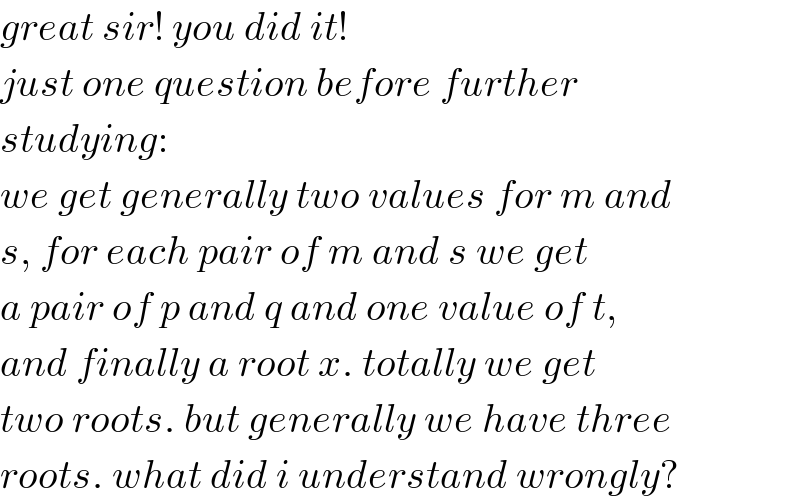
Question and Answers Forum
Question Number 79015 by ajfour last updated on 22/Jan/20
![Rigorously over one month′s time, I developed a formula for general cubic. x^3 +ax^2 +bx+c=0 let x=((pt+q)/(t+1)) pq=m, p+q=s ________________________ m^2 {(a^2 +b)^2 −6a(ab−c)} +m{2(b^2 +ac)(a^2 +b)− 3(ab−c)(ab+3c)} +(b^2 +ac)^2 −6bc(ab−c)=0 ________________________ s=−(2/3){((m(a^2 +b)+b^2 +ac)/(ab−c))} +{(8/(27))[((m(a^2 +b)+b^2 +ac)/(ab−c))]^3 −8[((m^3 +bm^2 +acm+c^2 )/(ab−c))]}^(1/3) p,q = (s/2)±(√((s^2 /4)−m)) t=−(((3pq^2 +2apq+ap^2 +2bp+bq+3c))/((p^3 +ap^2 +bp+c))) x=((pt+q)/(t+1)) . (Please help checking..) (edited a digit 1 in place of 4)](Q79015.png)
Commented by mr W last updated on 22/Jan/20

Commented by MJS last updated on 22/Jan/20
![doesn′t work for x^3 +3x^2 −13x−15=0 with x_1 =−5, x_2 =−1, x_3 =3 your method gives depending on the choice of p and q [t is not symmetric in p, q; so we have to decide p=(s/2)+... or p=(s/2)−...] x≈.172±.763 or x≈−1.43±2.53 btw. in this case m∉R](Q79037.png)
Commented by ajfour last updated on 22/Jan/20

Commented by TawaTawa last updated on 23/Jan/20

